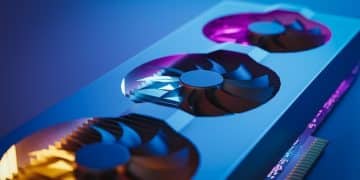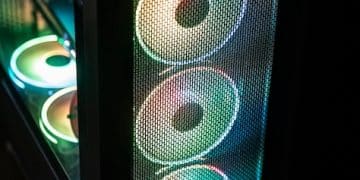Graphics Card Drivers: Optimal Performance & Stability

Keeping your graphics card drivers updated is crucial for ensuring optimal performance, preventing system instability, and unlocking new features in games and applications, directly influencing your visual computing experience.
In the dynamic world of PC gaming and professional design, the constant evolution of hardware and software demands meticulous attention to detail. Few components are as critical to a seamless visual experience as the graphics card, and its true potential hinges significantly on one often-overlooked element: its drivers. This article delves into why graphics card drivers: Keep your GPU updated for optimal performance and stability, exploring their vital role, the benefits of regular updates, and how to maintain them effectively.
Understanding Graphics Card Drivers
Graphics card drivers are essentially the software bridge between your operating system, applications, and your graphics processing unit (GPU). They translate the commands from software into instructions that your GPU can understand and execute, turning abstract data into the vivid images you see on your screen.
Without proper drivers, your graphics card would be little more than a piece of inert silicon. They are fundamental to its operation, influencing everything from basic display functionality to advanced graphical rendering in demanding applications and games. Think of them as the operating manual and interpreter for your GPU, guiding every pixel and frame.
The Foundational Role of Drivers
The primary function of a driver is to enable communication. When you launch a game or a video editing suite, the software sends out requests for graphical processing. It’s the driver’s job to receive these requests, parse them, and instruct the GPU on how to fulfill them efficiently. This intricate dance happens thousands of times a second, ensuring a fluid and responsive visual output.
- Hardware Abstraction: Drivers abstract the complexities of the hardware, allowing developers to code for a general interface rather than specific GPU models.
- Performance Optimization: They contain highly optimized code paths for various graphics APIs (like DirectX, OpenGL, Vulkan), ensuring the GPU is utilized to its fullest.
- Feature Enablement: New graphical features, rendering techniques, or hardware capabilities are often introduced and supported through driver updates.
Beyond simple functionality, drivers also manage resources, handle error reporting, and can even offer specialized profiles for specific applications. They are constantly refined by manufacturers to extract every last ounce of performance and stability from their hardware.
Why Regular Driver Updates are Crucial
The PC landscape is ever-evolving, with new games, software, and operating system updates released frequently. Regular graphics card driver updates are not merely optional; they are a necessity for anyone seeking to maximize their system’s potential, ensure compatibility, and prevent frustrating technical issues. The benefits extend far beyond just “getting better graphics.”
Performance Enhancements and Optimizations
One of the most compelling reasons to keep your drivers updated is the consistent performance boost they provide. GPU manufacturers invest heavily in refining their drivers, often releasing specific optimizations for new game titles or major software releases. These optimizations can lead to noticeable improvements in frame rates, reduced latency, and a smoother overall gaming or application experience.
Developers and hardware manufacturers collaborate closely. When a new game launches, the GPU makers release “game-ready” drivers that are specifically tuned to handle that game’s engine and graphical demands. This tuning can address performance bottlenecks and ensure the game runs as intended, often delivering a significant uplift compared to older driver versions.
- Increased Frame Rates: Direct optimizations frequently result in smoother gameplay with higher frames per second (FPS).
- Reduced Stuttering and Lag: Better resource management by updated drivers can minimize hitches and delays.
- Faster Rendering Times: For creative professionals, updated drivers can accelerate tasks like video editing, 3D rendering, and graphic design.
These performance gains aren’t just theoretical; they are often quantifiable and translate directly into a superior user experience, making your investment in high-end hardware truly pay off.
Improved Stability and Bug Fixes
Performance isn’t the only metric. Stability is equally, if not more, important. Outdated or buggy drivers are a leading cause of system crashes, visual glitches, and application failures. Hardware and software interactions are complex, and even minor incompatibilities can lead to frustrating blue screens of death (BSODs) or freezing applications.
Manufacturers continuously monitor feedback, identify bugs, and release driver updates to address these issues. A new driver version might fix an elusive crash that only appears with a specific game, resolve visual artifacting in certain applications, or improve overall system responsiveness. Staying updated is your best defense against these kinds of unpredictable problems.
Furthermore, operating system updates often introduce changes that require corresponding driver updates to maintain compatibility. Failing to update your GPU drivers after a major OS patch can lead to unexpected behavior and instability, emphasizing the interconnectedness of your system’s software components.

New Features and Compatibility
Beyond performance and stability, driver updates often bring new features, support for emerging technologies, and critical compatibility improvements. This ensures your graphics card remains relevant and capable in an ever-changing technological landscape.
Unlocking Advanced Capabilities
Graphics cards are powerful and versatile, and their full capabilities are often revealed through driver updates. New drivers can introduce support for cutting-edge technologies like real-time ray tracing, advanced upscaling techniques (NVIDIA DLSS, AMD FSR), and new industry standards. Without these updates, your hardware might physically support these features, but the software layer simply won’t enable them.
- Ray Tracing: Essential for enabling realistic lighting, reflections, and shadows in supported games and applications.
- Upscaling Technologies: Deliver near-native image quality at lower resolutions, drastically improving performance.
- New API Support: Ensures compatibility with the latest versions of DirectX, Vulkan, or OpenGL, which modern games and software rely on.
These feature additions can fundamentally transform your experience, offering visual fidelity and performance levels that were previously unattainable with older driver revisions. It’s akin to getting a free upgrade to your existing hardware.
Ensuring System and Software Compatibility
Software evolves rapidly. New games are developed on the latest engines, operating systems receive major revisions, and applications are continuously updated. Graphics drivers play a crucial role in maintaining seamless compatibility across this intricate ecosystem. An out-of-date driver might lead to:
Problems with new games: Modern games might not launch or perform poorly because they rely on features or optimizations present only in newer drivers. Visual artifacts: Unexplained graphical glitches, texture corruption, or rendering errors can often be traced back to outdated drivers. Software conflicts: Specific applications, especially resource-intensive ones like video editors or CAD software, can experience crashes or unexpected behavior due to driver incompatibilities.
Proactive driver updates mitigate these risks, ensuring your system remains a reliable and adaptable platform for all your computing needs. This proactive approach saves time and frustration by preventing issues before they arise.
How to Update Your Graphics Card Drivers
Updating your graphics card drivers is a straightforward process, but it requires attention to detail to ensure you’re downloading the correct software for your specific hardware. The two primary methods involve using the GPU manufacturer’s official software or manually downloading from their websites.
Using Manufacturer’s Software (Recommended)
Both NVIDIA and AMD, the two leading GPU manufacturers, provide dedicated software utilities designed to manage and update your graphics drivers. These are generally the safest and most convenient methods, as they automate the detection of your hardware and recommend the appropriate driver versions.
For NVIDIA Users: GeForce Experience
NVIDIA’s GeForce Experience application offers a streamlined way to keep your drivers updated. Once installed, it runs in the background and notifies you when new drivers are available. It also provides game optimization settings and other useful features.
- Launch GeForce Experience.
- Navigate to the “Drivers” tab.
- Click “Check for Updates” and then “Download” the latest driver.
- Choose “Express Installation” for a quick setup, or “Custom Installation” for more control (e.g., performing a clean install).
For AMD Users: Adrenalin Software
AMD’s equivalent is the Adrenalin Software (formerly Radeon Software Adrenalin Edition). Similar to GeForce Experience, it provides driver management, game optimization, and performance monitoring tools.
- Open the AMD Adrenalin Software.
- Go to the “Drivers & Software” section.
- Click “Check for Updates” and download the latest recommended driver.
- Proceed with the installation, usually opting for the recommended “Factory Reset” to perform a clean install.
These applications simplify the process, guiding you through each step and ensuring you install the correct driver for your specific GPU model.
Manual Driver Download and Installation
While manufacturer software is convenient, you can also manually download drivers directly from NVIDIA or AMD’s websites. This method is useful if you prefer a clean install without additional software, or if you’re troubleshooting driver issues.
- Identify your graphics card model: You can find this in Windows Device Manager under “Display adapters,” or by using tools like CPU-Z or GPU-Z.
- Visit the official driver download page for NVIDIA (nvidia.com/drivers) or AMD (amd.com/support/drivers).
- Select your specific GPU model from the dropdown menus (e.g., GeForce RTX 4080, Radeon RX 7900 XT).
- Choose your operating system (e.g., Windows 11 64-bit).
- Download the latest recommended driver package.
- Run the downloaded installer and follow the on-screen prompts.
For a clean install, especially if you’re experiencing issues, it’s often advisable to use a tool like Display Driver Uninstaller (DDU) in Safe Mode to completely remove old drivers before installing new ones. This ensures no residual files interfere with the new installation. However, this is for advanced users and typically not necessary for routine updates.
Troubleshooting Common Driver Issues
Even with careful management, graphics card driver issues can occasionally arise. These problems can range from minor annoyances to system crashes. Understanding common issues and their solutions can save considerable time and frustration.
Common Driver-Related Problems
Identifying the symptom is the first step towards a solution. Many problems, such as flickering screens or application failures, directly point to driver-related causes, though other underlying issues might generate similar symptoms. This requires diligent checking of all the system’s components.
- Black Screen or No Display: Often occurs after an update or if the driver is corrupted. The system may boot but show no signal to the monitor.
- Lag or Low FPS in Games: While sometimes hardware-related, a sudden drop in performance can stem from a driver conflict or an outdated driver with a new game patch.
- Crashes and Freezes: Applications or the entire system may crash, often accompanied by “Display driver stopped responding and has recovered” messages, or a Blue Screen of Death (BSOD).
- Visual Artifacts: Flickering, strange colors, checkerboard patterns, or distorted graphics can indicate a driver corruption or a failing GPU.
- Driver Installation Failure: The new driver simply won’t install, displaying an error message or freezing during the process.
These symptoms are strong indicators that your graphics drivers might be at the root of the problem. However, it’s always wise to rule out other hardware or software issues before solely blaming the drivers.

Effective Troubleshooting Steps
Addressing driver issues often involves a systematic approach, starting with the simplest solutions and progressing to more involved ones. Patience and careful observation are crucial during this process.
1. Reinstall the Latest Driver: The most common fix is to simply download the latest stable driver version again from the official manufacturer’s website and perform a clean installation. During installation, choose the “Custom” or “Advanced” option and select “Perform clean installation” or “Factory Reset” to remove previous driver files.
2. Roll Back Driver: If an issue arises immediately after a driver update, the new driver itself might be faulty or incompatible. Windows allows you to roll back to a previously installed driver version through Device Manager:
Right-click the Start button and select “Device Manager.” Expand “Display adapters,” right-click your GPU, and select “Properties.” Go to the “Driver” tab and click “Roll Back Driver” (if available). This is a quick way to revert if an update causes problems.
3. Use Display Driver Uninstaller (DDU): For persistent or complex issues, a clean sweep is often necessary. DDU is a third-party utility that thoroughly removes all remnants of graphics drivers. It’s recommended to run DDU in Windows Safe Mode to avoid conflicts. After running DDU, perform a fresh installation of the latest driver.
4. Check for System Updates: Ensure your operating system itself is fully updated. Sometimes, an OS patch can introduce or fix compatibility issues with graphics drivers. In addition, verifying directX and .NET framework updates is also important. These system components are used by games and applications along with the GPU drivers for optimal functioning.
5. Monitor Temperatures: Overheating can lead to performance throttling or crashes, which might be mistaken for driver problems. Use monitoring software (e.g., MSI Afterburner, HWiNFO) to check your GPU temperatures under load. Ensure proper cooling and dust removal from your PC case.
6. Test in Different Scenarios: If a problem occurs only in a specific game, try different games or applications. This helps determine if the issue is driver-wide or specific to a particular software interaction. This process will help you define what exactly is causing problems with your graphic card.
By methodically attempting these troubleshooting steps, you can resolve most common graphics driver issues, restoring your system to optimal performance and stability. When in doubt, consult official support forums or technical documentation for your specific GPU model.
Future of Graphics Drivers
The landscape of graphics technology is ceaselessly evolving, and with it, the role and complexity of graphics drivers. As hardware becomes more sophisticated and software demands more from GPUs, drivers are poised to become even more critical, integrating advanced intelligence and broader functionalities.
AI Integration and Machine Learning
One of the most significant trends transforming graphics drivers is the increasing integration of Artificial Intelligence (AI) and Machine Learning (ML). These technologies are no longer confined to specialized AI chips; they are being deeply woven into the fabric of GPU operations and driver logic. The future will see drivers that are more “intelligent” and adaptive.
For instance, AI can optimize driver performance in real-time, learning from user habits and application demands to dynamically adjust GPU settings for maximum efficiency or performance. This could mean fine-tuning clock speeds, power delivery, or memory allocation on the fly, leading to unprecedented levels of optimization without user intervention. Furthermore, AI could play a role in developing more efficient rendering techniques, predicting graphical needs, and reducing latency, thereby transforming the user experience to be even more seamless.
- Smart Performance Tuning: Drivers will use AI to automatically detect and apply optimal settings for games and applications based on system configurations and user preferences.
- Enhanced Upscaling: AI-powered upscaling (like DLSS and FSR) will continue to evolve, offering even greater image fidelity and performance gains across a wider range of hardware.
- Predictive Rendering: Machine Learning could enable GPUs to predict future frames or graphical elements, reducing rendering latency and improving responsiveness, especially in VR and AR.
This intelligent evolution will make drivers far more sophisticated than the simple software interfaces of today, pushing the boundaries of what’s possible in graphics rendering and computational tasks.
Cloud Integration and Streamlined Updates
The shift towards cloud computing and services will likely influence how graphics drivers are delivered and managed. We might see a future where driver updates are more seamlessly integrated with operating systems or even managed primarily through cloud-based services, reducing the burden on individual users.
Imagine a scenario where your operating system or a central hub dynamically fetches and deploys driver updates based on your installed applications and hardware, without requiring manual checks or large downloads. This cloud-centric approach could ensure that systems are always running the most optimized and stable driver versions, minimizing user effort and potential conflicts.
Moreover, cloud gaming and virtualized GPU environments will necessitate highly efficient and responsive drivers that can operate seamlessly within a distributed computing model. This will demand new paradigms for driver development, focusing on low latency, high throughput, and robust error handling in a network-dependent context.
The future of graphics drivers points towards greater automation, intelligence, and integration, ensuring that as hardware progresses, the software layer keeps pace, unlocking new possibilities for visual computing and user interaction.
| Key Point | Brief Description |
|---|---|
| 🎮 Performance Boost | Regular updates optimize your GPU for new games, improving FPS and overall smoothness. |
| 🛡️ Enhanced Stability | Updates include critical bug fixes, reducing crashes and various graphical glitches. |
| ✨ New Features | Unlock support for cutting-edge technologies like ray tracing and AI upscaling. |
| 🔧 Troubleshooting Aid | Knowing how to update helps resolve many common display and system issues. |
Frequently Asked Questions About Graphics Drivers
You can identify your graphics card by right-clicking on the Start button, selecting “Device Manager,” and then expanding “Display adapters.” Your GPU model will be listed there. Alternatively, running a diagnostic tool like DXDiag (type “dxdiag” in Windows Search) or dedicated third-party tools like GPU-Z can provide detailed information about your hardware.
For most users, checking for updates monthly or bi-monthly is sufficient. However, if a new major game title or significant software update is released, it’s advisable to check sooner, as manufacturers often release “game-ready” or optimized drivers around these times. Using manufacturer software like GeForce Experience or AMD Adrenalin can automate notifications.
While rare, new driver versions can sometimes introduce unexpected issues or incompatibilities. If you experience problems after an update (e.g., instability, performance issues), it’s recommended to roll back to the previous driver version through Device Manager or perform a clean install using a tool like Display Driver Uninstaller (DDU) before trying a different driver version.
A clean installation involves completely removing all old driver files and associated software before installing the new driver. This prevents conflicts and corruption that can arise from residual files. Most manufacturer installers (like NVIDIA’s or AMD’s) offer a “clean install” option, or you can use a third-party tool like Display Driver Uninstaller (DDU) for a more thorough removal.
Yes, integrated graphics also require driver updates for optimal performance, stability, and feature support. Updates for integrated graphics are typically provided by the CPU manufacturer (Intel, AMD) or directly through Windows Update. Keeping these drivers current is equally important, especially for basic gaming or multimedia tasks on systems without a dedicated GPU.
Conclusion
In summation, the importance of maintaining up-to-date graphics card drivers cannot be overstated. They are the invisible workforce ensuring your GPU operates at its peak, delivering not just higher frames per second in games but also ensuring overall system stability and unlocking the latest technological advancements. Regularly checking for and installing the latest drivers is a simple yet profoundly impactful practice for any PC user, transforming a potentially frustrating experience into a consistently smooth and visually rich one. It’s an essential element of modern system maintenance that pays dividends in performance and reliability.





